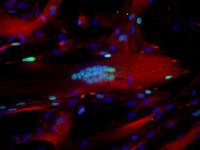Under the direction of Fabrice Chrétien*, in collaboration with Shahragim Tajbakhsh**, researchers from the Institut Pasteur, the Université de Versailles Saint-Quentin-en-Yvelines, the Paris Public Hospital Network (AP-HP), and the CNRS have shown for the first time in humans and mice, the capacity of stem cells to adopt a dormant state when their environment becomes hostile, including several days after death. This ability to significantly reduce metabolic activity enables them to preserve their potential for cellular division, even after extended periods post mortem. After isolation, they can then be used to repair damaged organs or tissues. This discovery could lead to new therapeutic avenues for treating numerous diseases. The study is being published today in the journal Nature communications.
Press release
Paris, june 12, 2012

In light of this astonishing result, scientists then sought to characterize these cells to understand how they survive in such adverse conditions. They observed that these cells enter a deeper state of quiescence, drastically lowering their metabolism. This so-called "dormant" state is a result of cellular organization that is stripped to the bare minimum: fewer mitochondria (cellular power plants using oxygen to produce energy in cells) and diminished stores of energy.
“We can compare this to pathological conditions where cells are severely deficient in resources, before regaining a normal cell cycle for regenerating damaged tissues and organs, explains Fabrice Chrétien. When muscle is in the acute phase of a lesion, the distribution of oxygen is highly disrupted. We have even observed that muscle stem cells in anoxia (totally deprived of oxygen) at 4°C have a better survival rate than those regularly exposed to ambient levels of oxygen.”
The team of Fabrice Chrétien then wondered if these results were consistent with other cell types. Tests were then done on stem cells taken from bone marrow where blood cells are produced. These cells remained viable for four days in post mortem mice models, and more importantly, they retained their capacity to reconstitute tissue after a bone marrow transplant.
This discovery could form the basis of a new source, and more importantly new methods of conservation, for stem cells used to treat a number of pathologies. This is the case for leukemia, for example, which requires a bone marrow transplant to restore a patient's blood and immune cells destroyed by chemotherapy and radiation. By harvesting stem cells from the bone marrow of consenting donors post mortem, doctors could address to a certain extent the shortage of tissues and cells. Although highly promising, this approach in the realm of cellular therapy still requires more testing and validation before it can be used in clinical applications. Nevertheless, it paves the way to investigate the viability of stem cells from all tissues and organs post mortem.
* Fabrice Chrétien, Neuropathologist, is head of the Human Histopathology and Animal Models Unit at the Institut Pasteur, and Professor of Histology at the Université de Versailles Saint-Quentin-en-Yvelines and the Raymond Poincaré Hospital (AP-HP) in Garches as part of the Pathology Department.
** Shahragim Tajbakhsh is Professor at the Institut Pasteur where he heads the Stem Cells and Development Unit (Institut Pasteur/CNRS Unit).
Illustration – © Institut Pasteur
Myotube (which is the fusion of several stem cells) obtained in vitro from a human muscle harvested 17 days post mortem.
Source
Skeletal muscle stem cells adopt a dormant cell state post mortem and retain regenerative capacity, Nature communications, June 12, 2012.
Mathilde Latil1,2,3, Pierre Rocheteau4, Laurent Châtre5, Serena Sanulli4,†, Sylvie Mémet6,7, Miria Ricchetti5, Shahragim Tajbakhsh4*, Fabrice Chrétien1,2,8*
1 Institut Pasteur, Human Histopathology and Animal Models Unit, Infection & Epidemiology Department; 25 rue du Dr Roux, Paris, France
2 Université de Versailles Saint-Quentin-en-Yvelines (UVSQ), Faculty of Medicine, Versailles, France
3 Université Paris Est, Créteil, France
4 Institut Pasteur, CNRS URA 2578, Stem Cells & Development, Department of Developmental Biology, CNRS URA 2578, Institut Pasteur, 25 rue du Dr Roux, Paris, France
5 Institut Pasteur, CNRS UMR 3525, Yeast Molecular Genetics Unit, 25 rue du Dr Roux, Paris, France
6 Institut Pasteur, Molecular Mycology Unit, Infection & Epidemiology Department, F-75015 Paris, France
7 CNRS, URA3012, Paris, France
8 Paris Public Hospital Network, AP-HP, Department of Anatomical Pathology and Forensic Medicine, Raymond Poincaré Hospital, Garches, France
† Institut Curie, Mechanisms of repression by polycomb group proteins, Unit of genetics and developmental biology, INSERM U934, CNRS UMR3215, 26 rue d’Ulm, Paris, France
* These authors contributed equally to this work
Contacts
Institut Pasteur Press Office
Sabine D'Andrea / +33 (0)1 44 38 92 17
Nadine Peyrolo / +33 (0)1 45 68 81 47
presse@pasteur.fr



